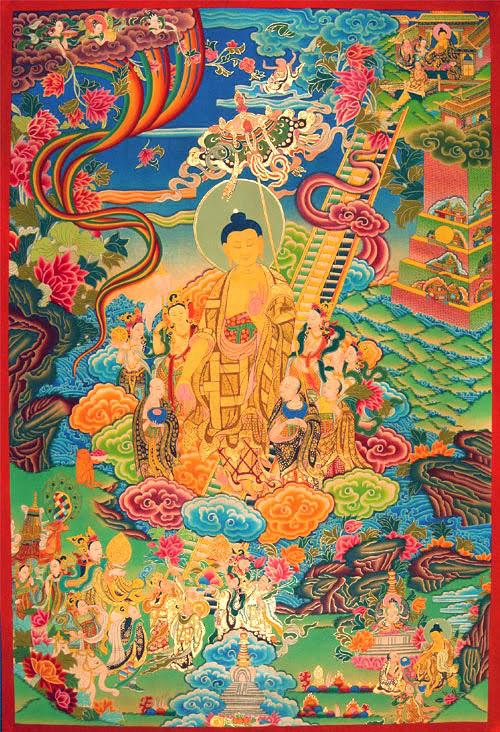Dear Friends,
Happy Lhabab Duchen, the Buddha's Descent from the Deva Realm of the Thirty-three! Today, October 31, is the Buddhist holy day of Lhabab Duchen, commemorating the day when Guru Shakyamuni Buddha returned to Earth from the god realm Thirty-Three after teaching Dharma for several months to the gods there, including his mother, Mayadevi.
Lhabab Duchen, one of the four great holy days of the Buddhist calendar, is a merit multiplying day, the karmic results of actions done on this day are multiplied 100 million times. You can find Lama Zopa Rinpoche's recommended practices for these karmically powerful days on the FPMT website.
As cited by Rinpoche from the Vinaya text Treasure of Quotations and Logic, the merit created by actions done on these special days is multiplied by one hundred million. We invite you to take advantage of this meritorious day by making your donation and partnering with us to bring these precious teachings of Lama Yeshe and Lama Zopa Rinpoche to the world.
GURU PUJA IS THE HEART PRACTICE: Making Requests to the Gurus
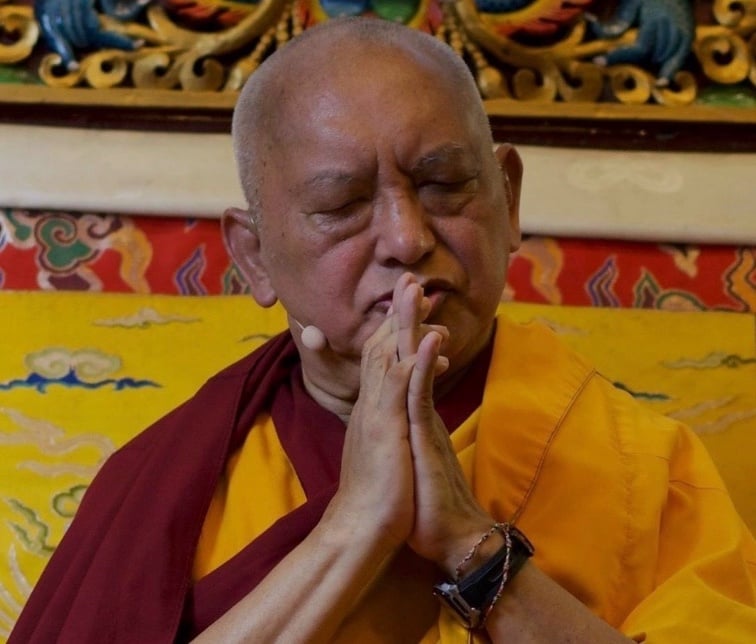 We are delighted to share with you the fourth installment in the Guru Puja is the Heart Practice series: Making Requests to the Gurus, edited by Venerable Sarah Thresher with Megan Evart. The goal of this six-part multimedia series is to preserve and spread Rinpoche’s lineage of practice for the Guru Puja in his own words, audio, video, photos and text.
We are delighted to share with you the fourth installment in the Guru Puja is the Heart Practice series: Making Requests to the Gurus, edited by Venerable Sarah Thresher with Megan Evart. The goal of this six-part multimedia series is to preserve and spread Rinpoche’s lineage of practice for the Guru Puja in his own words, audio, video, photos and text.
Guru Puja is the Heart Practice series includes:
Part One: The Importance of Practicing Guru Puja
Part Two: An Introduction to the Chanting Lineage of the Guru Puja
Part Three: The Seven-Limb Practice
Part Four: Making Requests to the Gurus
Part Five: The Tsog Offering (forthcoming)
Part Six: The Lamrim Prayer to the Verses of Auspiciousness (forthcoming)
In order for our meditation on the lamrim to be effective in transforming our minds into the Dharma, we must first receive the guru’s blessings. Making Requests to the Gurus brings together video, audio and images to accompany Rinpoche’s teachings and commentary on the Guru Puja's series of requests for the guru’s blessings. Most recently Venerable Sarah had the opportunity to share with Rinpoche the multimedia presentation during the Guru Puja teachings in Singapore in September. Here is what she reports:
The postponement of a Most Secret Hayagriva Retreat in Penang, Malaysia, scheduled for the fall of this year, turned out to be an unexpected boon as Lama Zopa Rinpoche took the opportunity instead to offer precious teachings on the Guru Puja at Amitabha Buddha Centre.
I was extremely fortunate not only to be able to attend this year’s teachings but also to have an opportunity to show Rinpoche our multimedia presentation Guru Puja is the Heart Practice—a collection of instructions and advice given by Rinpoche over the years at teachings and retreats on the Guru Puja chanting and practice.
Rinpoche took the time to glance through the series, giving very useful feedback and answering many questions. He appeared to particularly enjoy some of the stunning photos in the series. I was especially encouraged when Rinpoche explained that this year’s teachings on the Guru Puja in Singapore are in preparation for a series of future teachings on the Guru Puja based on additional commentaries. These new teachings will be incorporated into this series.
New Podcasts: Purifying the Mind of Pride and an Interview with Rinpoche
So main thing is by practicing oneself as lower, then pride does not rise.
-Lama Zopa Rinpoche
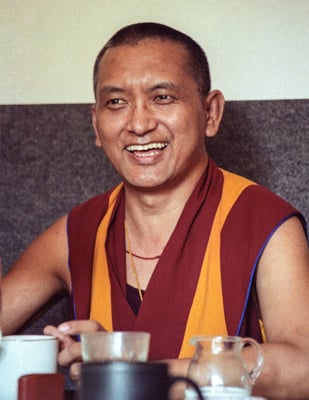 This month on the LYWA podcast is a wonderful selection from Lama Zopa Rinpoche’s 2003 commentary on Eight Verses of Thought Transformation, an essential mind training text composed by Kadampa Geshe Langri Tangpa. This teaching was given at Tse Chen Ling Center, in San Francisco, California. Rinpoche explains why we must purify the mind of pride, how to prepare our mind to be able to see ourselves as lower than all others and describes the great joy we will feel upon accomplishing this powerfully medicinal state of mind. You can read along with the transcript here.
This month on the LYWA podcast is a wonderful selection from Lama Zopa Rinpoche’s 2003 commentary on Eight Verses of Thought Transformation, an essential mind training text composed by Kadampa Geshe Langri Tangpa. This teaching was given at Tse Chen Ling Center, in San Francisco, California. Rinpoche explains why we must purify the mind of pride, how to prepare our mind to be able to see ourselves as lower than all others and describes the great joy we will feel upon accomplishing this powerfully medicinal state of mind. You can read along with the transcript here.
The LYWA podcast contains hundreds of hours of audio, each with links to the accompanying lightly edited transcripts. See the LYWA podcast page to search or browse the entire collection by topic or date, and for easy instructions on how to subscribe.
Also don't miss out on listening to an interview with Rinpoche! Daniel Aitken, the director at Wisdom Publications, interviewed Rinpoche during Rinpoche's recent August 2018 visit to the Kurukulla Center in Boston. Daniel spoke with Rinpoche about how Buddhism in the West has evolved and changed since the development of FPMT in 1975. You can listen to the podcast or watch the video version here.
New Teachings on Our Companion Website
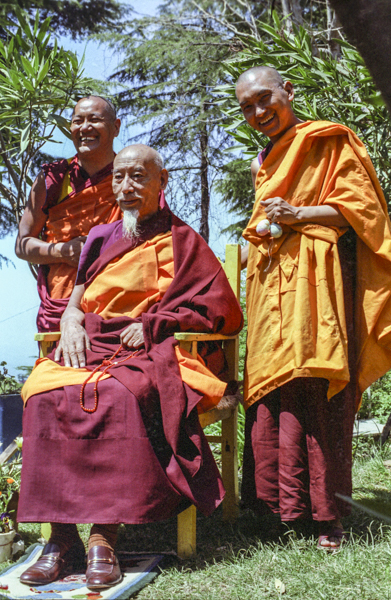 We posted a commentary given by Geshe Lama Konchog on A Commentary on the Seven-Point Mind Training on Teachings From Tibet, our new companion website. This teaching was given by Geshe Lama Konchog at Atisha Centre, Bendigo, Australia, from October 31 to November 3, 1987. Translated by Dhawa Dundrup. Transcribed and edited by Ven. Thupten Konchog. It is also available for download as a free PDF from Amitabha Buddhist Centre, Singapore.
We posted a commentary given by Geshe Lama Konchog on A Commentary on the Seven-Point Mind Training on Teachings From Tibet, our new companion website. This teaching was given by Geshe Lama Konchog at Atisha Centre, Bendigo, Australia, from October 31 to November 3, 1987. Translated by Dhawa Dundrup. Transcribed and edited by Ven. Thupten Konchog. It is also available for download as a free PDF from Amitabha Buddhist Centre, Singapore.
The website Teachings From Tibet launched late last year and was inspired by our 2005 free publication titled Teachings From Tibet that included teachings given by great Tibetan masters to western students visiting India and Nepal in the 70's and 80's. Over the years, the Archive has received additional transcripts of teachings given by these great lamas so we wanted to make this extensive collection more accessible to you. We hope you enjoy them!
New Translations Into Portuguese and Russian
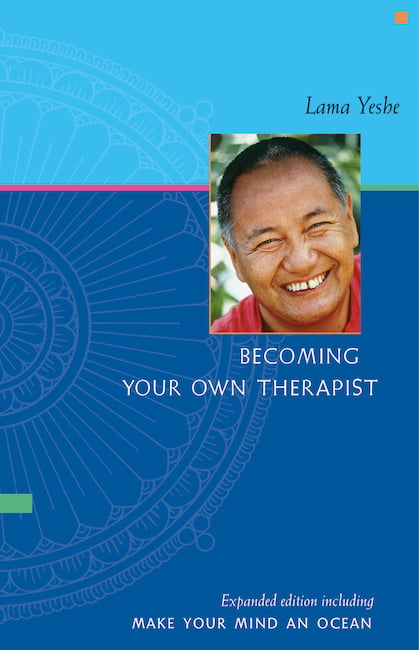 We are happy to share that Becoming Your Own Therapist by Lama Thubten Yeshe has recently been translated into Brazilian Portuguese by Marly Ferreira. You can find the PDF link to this translation and more Portuguese translations here.
We are happy to share that Becoming Your Own Therapist by Lama Thubten Yeshe has recently been translated into Brazilian Portuguese by Marly Ferreira. You can find the PDF link to this translation and more Portuguese translations here.
We also have a new Russian translation to share with you, Life, Death And After Death by Lama Thubten Yeshe and translated by Anastasia Stoliarova. You can download it the PDF and find many more Russian translations here.
We are grateful to work with so many amazing translators who make our publications and transcripts available in languages other than English. Please see our website for links to translations in sixteen languages.
Big Love: The Life and Teachings of Lama Yeshe
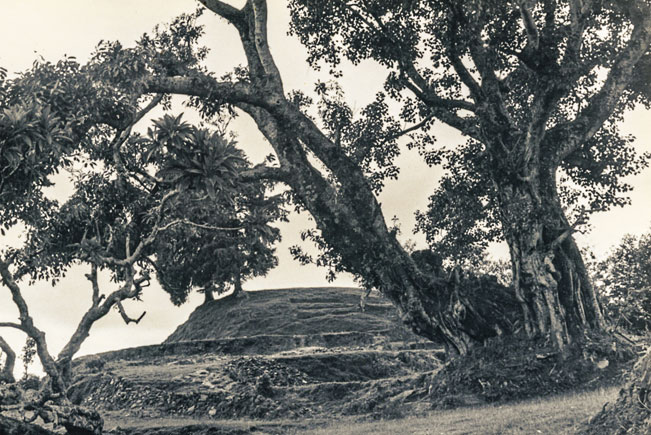 This is what the Kopan hill looked like when the Lamas found it in 1969. Look at it now! Check out this amazing drone video taken this year. Big Love details how all this came about.
This is what the Kopan hill looked like when the Lamas found it in 1969. Look at it now! Check out this amazing drone video taken this year. Big Love details how all this came about.
Work on this major project continues apace, with the first volume already designed and the second volume well under way. It’s now looking like the book will be published early next year, not this year, as we first thought. It’s a huge project! We are delighted to offer you a brief excerpt below.
If you would like to support this project, please do so here. Thank you so much!
Much love,

Nick Ribush
Director
THIS MONTH'S TEACHING: An Excerpt from BIG LOVE
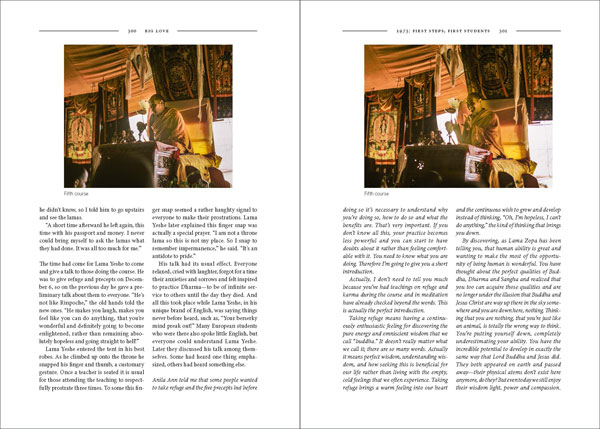 The time had come for Lama Yeshe to come and give a talk to those doing the [fifth Kopan meditation] course. He was to give refuge and precepts on December 6, so on the previous day he gave a preliminary talk about them to everyone. “He’s not like Rinpoche,” the old hands told the new ones. “He makes you laugh, makes you feel like you can do anything, that you’re wonderful and definitely going to become enlightened, rather than remaining absolutely hopeless and going straight to hell!”
The time had come for Lama Yeshe to come and give a talk to those doing the [fifth Kopan meditation] course. He was to give refuge and precepts on December 6, so on the previous day he gave a preliminary talk about them to everyone. “He’s not like Rinpoche,” the old hands told the new ones. “He makes you laugh, makes you feel like you can do anything, that you’re wonderful and definitely going to become enlightened, rather than remaining absolutely hopeless and going straight to hell!”
Lama Yeshe entered the tent in his best robes. As he climbed up onto the throne he snapped his finger and thumb, a customary gesture. Once a teacher is seated it is usual for those attending the teaching to respectfully prostrate three times. To some this finger snap seemed a rather haughty signal to everyone to make their prostrations. Lama Yeshe later explained this finger snap was actually a special prayer. “I am not a throne lama so this is not my place. So I snap to remember impermanence,” he said. “It’s an antidote to pride.”
His talk had its usual effect. Everyone relaxed, cried with laughter, forgot for a time their anxieties and sorrows and felt inspired to practice Dharma—to be of infinite service to others until the day they died. And all this took place while Lama Yeshe, in his unique brand of English, was saying things never before heard, such as, “Your berserky mind preak out!” Many European students who were there also spoke little English, but everyone could understand Lama Yeshe. Later they discussed his talk among themselves. Some had heard one thing emphasized, others had heard something else.
Anila Ann told me that some people wanted to take refuge and the five precepts but before doing so it’s necessary to understand why you’re doing so, how to do so and what the benefits are. That’s very important. If you don’t know all this, your practice becomes less powerful and you can start to have doubts about it rather than feeling comfortable with it. You need to know what you are doing. Therefore I’m going to give you a short introduction.
Actually, I don’t need to tell you much because you’ve had teachings on refuge and karma during the course and in meditation have already checked beyond the words. This is actually the perfect introduction.
Taking refuge means having a continuously enthusiastic feeling for discovering the pure energy and omniscient wisdom that we call “buddha.” It doesn’t really matter what we call it; there are so many words. Actually it means perfect wisdom, understanding wisdom, and how seeking this is beneficial for our life rather than living with the empty, cold feelings that we often experience. Taking refuge brings a warm feeling into our heart and the continuous wish to grow and develop instead of thinking, “Oh, I’m hopeless, I can’t do anything,” the kind of thinking that brings you down.
By discovering, as Lama Zopa has been telling you, that human ability is great and wanting to make the most of the opportunity of being human is wonderful. You have thought about the perfect qualities of Buddha, Dharma and Sangha and realized that you too can acquire those qualities and are no longer under the illusion that Buddha and Jesus Christ are way up there in the sky somewhere and you are down here, nothing. Thinking that you are nothing, that you’re just like an animal, is totally the wrong way to think. You’re putting yourself down, completely underestimating your ability. You have the incredible potential to develop in exactly the same way that Lord Buddha and Jesus did. They both appeared on earth and passed away—their physical atoms don’t exist here anymore, do they? But even today we still enjoy their wisdom light, power and compassion.
When Lord Buddha was here, his body was not an ordinary body. Through the power of his bodhicitta, to use Buddhist terminology, whenever people saw his body they gained higher realizations, such as single-pointed concentration. But when he was finished on the physical level, his knowledge, the power of his wisdom, lived on such that we can still feel it today. This is the result of the wisdom and true compassion of his bodhicitta mind. So I’m saying that discovering that you have the ability or potential to develop that within you, that you can grow continuously without stopping, no matter what happens to your physical body, your mind can be completely relaxed. Even though you get old, changing, changing, changing, on the mental level you can continuously develop and better understand your own nature and no matter that the external world goes up and down, your internal world is always supported by your understanding. You are supported by your wisdom in the middle way rather than falling this way or that.
We talk about eternal happiness, eternal bliss, eternal joy—these qualities last forever, unlike the momentary, transient pleasures of samsara. And they arise from knowledge-wisdom. So taking refuge in Buddha, Dharma and Sangha means you are taking refuge in Lord Buddha’s ultimate wisdom, true compassion and everlasting bliss.
Think what a fantastic state of mind that is. Just imagining it brings you energy. I mean, you haven’t yet attained it but just visualizing the omniscient mind, thinking about it, brings its reflection into your mind. You feel more peaceful and relaxed. A sensation of happiness comes into your mind; a warm feeling, a really warm feeling. By discovering that such qualities lie within you makes you also respect other sentient beings’ abilities and stops you from putting them down, too: “You can’t do anything; you’re hopeless.” That’s not right. By discovering your own abilities, you respect others and generate warm feelings toward them rather than hatred. It’s so simple.”
Excerpted from the 1973 chapter of Big Love, by Adele Hulse, forthcoming from LYWA in 2019.
























